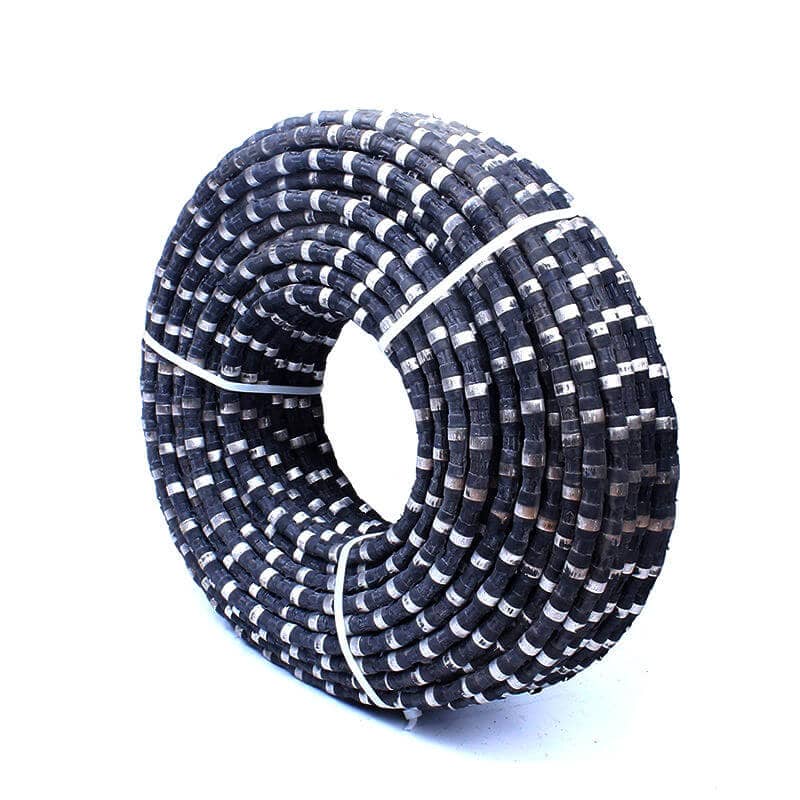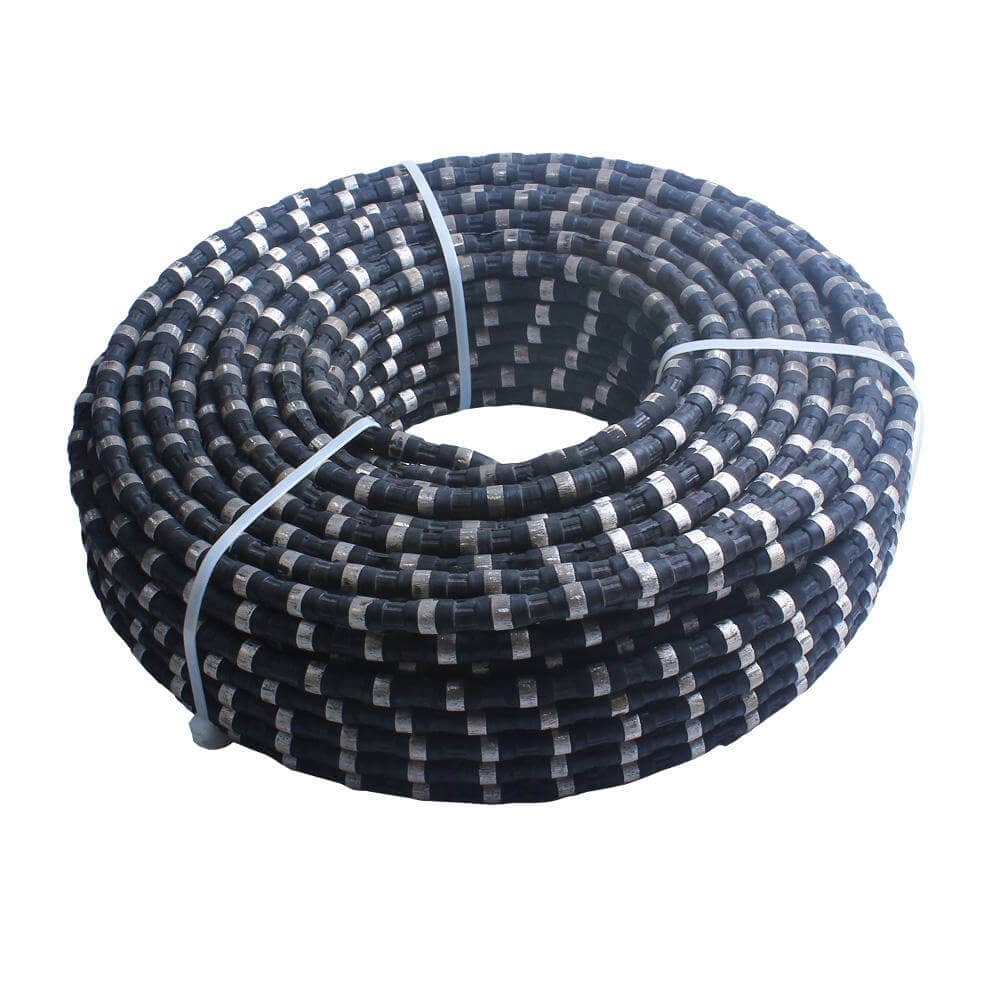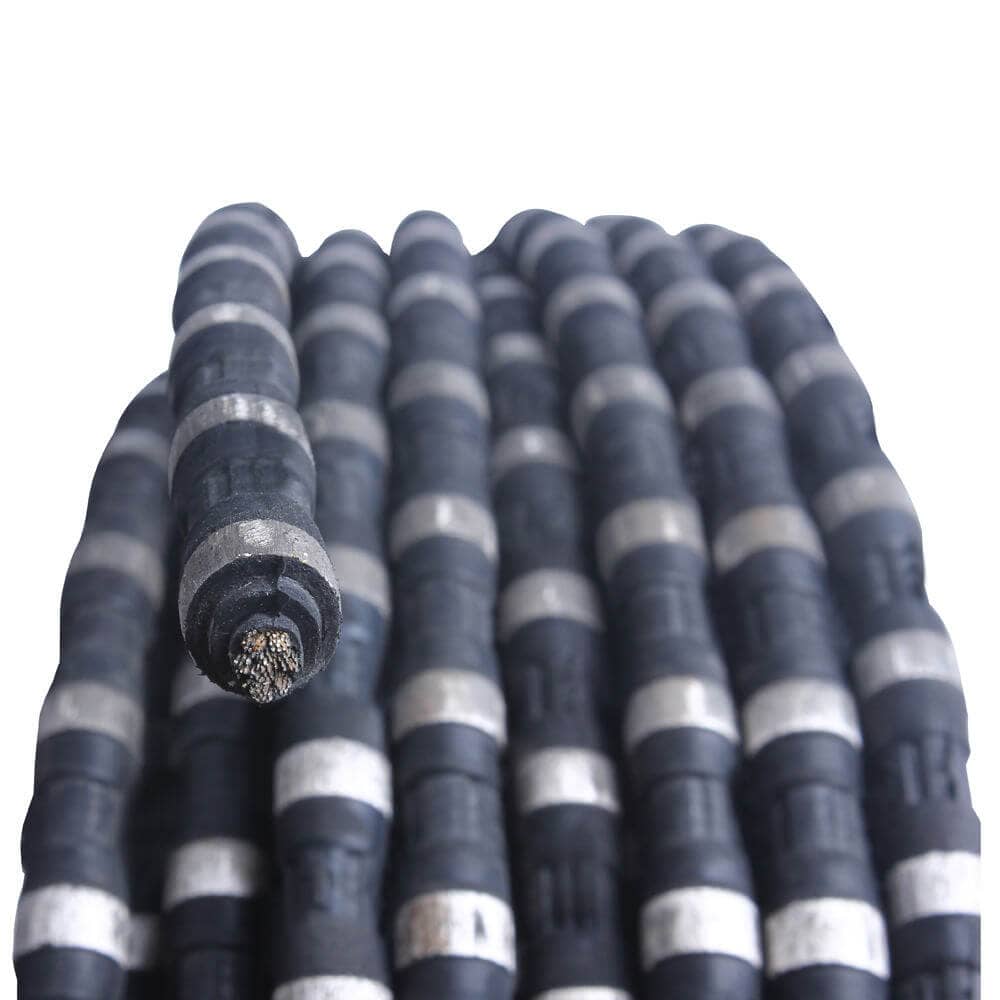Introduction of diamond wire saw for marble quarrying:
Quarry mining is a challenging and labor-intensive process that involves extracting natural stone from the earth’s crust. Marble, known for its elegance and versatility, has been a popular choice in construction and design for centuries. To meet the growing demand for this exquisite stone, innovative tools have been developed to enhance efficiency and productivity. One such groundbreaking technology is the diamond wire saw. In this article, we will explore the comprehensive details of diamond wire saws for marble quarrying and their significant impact on the industry.
Understanding Diamond Wire Saw Technology:
Diamond wire saws are powerful cutting tools specifically designed for quarry mining operations. They consist of a steel wire cable embedded with synthetic diamonds, which act as cutting agents. This unique combination enables diamond wire saws to slice through marble with exceptional precision and speed. The diamond beads along the wire have different diameters and are spaced at regular intervals to ensure consistent cutting performance.
Advantages of Diamond Wire Saw for Marble Quarrying:
Increased Efficiency:
Diamond wire saws have revolutionized the extraction process by significantly reducing the time and effort required for cutting through marble blocks. Their high cutting speed and smooth operation allow for quicker material extraction, leading to enhanced productivity and cost-effectiveness.
Precise Cutting:
The use of synthetic diamonds as cutting agents ensures precise cutting with minimal material wastage. Diamond wire saws can create clean and accurate cuts, enabling quarry operators to maximize the yield of high-quality marble slabs and minimize the amount of material that goes to waste.
Versatility:
Diamond wire saws offer unparalleled versatility, allowing quarry operators to extract marble of varying sizes and shapes. They can be adjusted to accommodate the specific requirements of each quarry, enabling efficient extraction of marble blocks of different dimensions.
Safety and Environmental Benefits:
Compared to traditional quarrying methods, diamond wire saws offer improved safety features, as they minimize the risks associated with manual cutting tools. Additionally, they produce less noise, dust, and vibration, making them more environmentally friendly and conducive to a sustainable mining operation.
Factors Affecting Diamond Wire Saw Performance:
Wire Tension:
Proper tensioning of the diamond wire is crucial for optimum cutting performance. Maintaining the correct tension helps ensure consistent cutting speed and prolongs the life of the wire.
Diamond Quality and Bead Design:
The quality of the synthetic diamonds used in the wire and the design of the diamond beads play a significant role in the cutting efficiency and lifespan of the wire saw. High-quality diamonds and well-designed beads result in improved cutting performance and longevity.
Cutting Parameters:
Adjusting the cutting parameters, such as wire speed and water flow, can optimize the cutting process for different types of marble and quarry conditions. It is essential to find the right balance to achieve optimal cutting efficiency.
Maintenance and Care:
Proper maintenance and care are vital to ensure the longevity and performance of diamond wire saws. Regular inspections, cleaning, and lubrication of the wire and components, along with routine replacement of worn-out beads, are necessary to maintain cutting efficiency and reduce downtime.
Diamond wire saws have transformed the marble quarrying industry by offering enhanced efficiency, precision, and versatility. These innovative tools have revolutionized the way marble is extracted, providing numerous advantages over traditional cutting methods. With their ability to produce clean and accurate cuts while minimizing material wastage, diamond wire saws have become indispensable in modern quarry mining operations. As technology continues to advance, we can expect further improvements in diamond wire saw performance, making marble quarrying even more efficient and sustainable in the years to come.
Wire Composition:
The steel wire used in diamond wire saws is typically made from high-strength steel cables. These cables are carefully selected to withstand the tension required for cutting through the marble blocks. The wire is often coated with rubber or plastic to provide protection against wear and tear and to enhance grip during operation.
Wire Length and Diameter:
The length and diameter of the diamond wire are crucial factors in determining the cutting capacity and performance. Longer wires allow for the extraction of larger marble blocks, while shorter wires are suitable for smaller-scale operations. The diameter of the wire can vary depending on the specific requirements of the quarry, with thicker wires being more robust and capable of withstanding higher tensions.
Cutting Process:
During the cutting process, the diamond wire is threaded through a series of pulleys or guide wheels, forming a continuous loop. The tension applied to the wire is carefully controlled to ensure optimum cutting performance. Water is continuously sprayed onto the cutting area to cool the wire, reduce friction, and remove debris, improving cutting efficiency and prolonging the life of the wire.
Wire Speed and Water Flow:
The speed at which the diamond wire moves through the marble block is a critical parameter in achieving efficient cutting. Higher wire speeds can result in faster cutting but may compromise precision, while slower speeds may lead to increased cutting time. Similarly, the water flow rate must be appropriately adjusted to maintain cooling and lubrication without excessive waste.
Maintenance and Replacement:
Regular maintenance of diamond wire saws is essential for optimal performance and longevity. This includes inspecting the wire for signs of wear or damage, cleaning the wire and components, and lubricating moving parts. It is also necessary to monitor the diamond beads’ condition and replace worn-out or damaged beads to maintain cutting efficiency and prevent wire breakage.
Applications Beyond Quarrying:
Diamond wire saws are not limited to marble quarrying. They are also widely used in other applications, including stone processing, construction, and demolition. In stone processing, diamond wire saws are used to cut slabs, blocks, and intricate shapes from various types of stone. In construction and demolition, diamond wire saws are employed to cut through reinforced concrete, metal, and other materials with precision and efficiency.
Advancements in Diamond Wire Saw Technology:
The diamond wire saw technology continues to evolve, with ongoing research and development efforts aimed at enhancing cutting performance, durability, and sustainability. Manufacturers are constantly working to improve the design of diamond beads, optimize the bonding of diamonds to the wire, and develop innovative wire tensioning systems. These advancements contribute to more efficient and cost-effective quarry mining processes.
Diamond wire saws have truly transformed marble quarrying, enabling faster, safer, and more precise extraction of this exquisite natural stone. Their numerous advantages, such as increased efficiency, precise cutting, versatility, and environmental benefits, have made them indispensable tools in the industry. With ongoing technological advancements, we can expect diamond wire saws to continue driving innovation and productivity in quarry mining operations worldwide.
Applications of diamond wire saws?
Diamond wire saws find applications beyond quarrying. Here are some other industries and fields where diamond wire saws are extensively used:
Stone Processing and Sculpting:
Diamond wire saws are widely employed in the stone processing industry for cutting slabs, blocks, and intricate shapes from a variety of natural and engineered stones. They enable precise and efficient shaping of stone materials for architectural elements, sculptures, countertops, and other decorative applications.
Construction and Demolition:
Diamond wire saws are valuable tools in the construction and demolition industry. They are used to cut through reinforced concrete, masonry, metal, and other tough materials with high precision. Diamond wire saws are particularly useful for controlled demolition projects, where it is necessary to cut through structures without causing excessive vibrations or damage to adjacent areas.
Mining and Extraction:
In addition to quarry mining, diamond wire saws are employed in various mining operations. They are used for extracting other natural stones, such as granite, limestone, and sandstone. Diamond wire saws offer significant advantages over traditional drilling and blasting methods in terms of safety, precision, and minimizing environmental impact.
Nuclear Decommissioning:
Diamond wire saws play a crucial role in the decommissioning of nuclear facilities. They are used to cut through concrete, steel, and other materials to safely dismantle nuclear structures and equipment. The precise cutting capability of diamond wire saws allows for controlled removal of radioactive components without causing unnecessary dispersion of contaminants.
Aerospace Industry:
Diamond wire saws are utilized in the aerospace industry for various applications, including cutting advanced composites, titanium, and other exotic materials used in aircraft manufacturing. Their precise cutting ability and minimal heat generation make them suitable for intricate and high-strength material cutting requirements.
Research and Development:
Diamond wire saws are also employed in research and development laboratories for cutting and sectioning samples of materials. They are commonly used in scientific studies, material characterization, and quality control processes.
Art and Jewelry:
Diamond wire saws find application in the creation of intricate art pieces and the cutting and shaping of precious gemstones. They enable artisans and jewelers to achieve precise cuts and intricate designs on various materials, including metals, gemstones, and glass.
Rescue and Emergency Situations:
Diamond wire saws are utilized by emergency response teams, such as firefighters and search and rescue teams, to cut through debris and materials during rescue operations. They provide a quick and efficient method for gaining access to trapped individuals in collapsed structures or other emergency situations.
These are just a few examples of the diverse applications of diamond wire saws. Their versatility, precision, and cutting efficiency make them invaluable tools in various industries where materials need to be cut with accuracy and minimal damage.
How do diamond wire saws compare to other cutting tools in terms of cost?
When comparing diamond wire saws to other cutting tools, such as traditional saws or abrasive cutting methods, it’s essential to consider both the initial cost and the overall cost-effectiveness over time. Here are some key points to consider regarding the cost of diamond wire saws:
Initial Investment:
Diamond wire saws typically have a higher initial investment compared to traditional cutting tools. This is primarily due to the advanced technology, engineering, and materials used in their construction. The cost of the diamond wire itself, which contains synthetic diamonds, contributes to the higher upfront expense. However, the initial investment can vary depending on the specific model, size, and brand of the diamond wire saw.
Cutting Efficiency and Productivity:
Diamond wire saws excel in terms of cutting efficiency and productivity. They can cut through various materials, including marble, granite, and concrete, with precision and speed. Compared to traditional cutting tools, diamond wire saws often offer faster cutting speeds, resulting in increased productivity and reduced labor costs. The ability to make precise cuts and minimize material wastage can also contribute to cost savings.
Longevity and Durability:
Diamond wire saws are designed to be durable and long-lasting, especially when used and maintained correctly. While they may require occasional maintenance and replacement of components like diamond beads, they generally have a longer lifespan compared to traditional cutting tools. This longevity can result in cost savings over time, as there is less frequent need for tool replacement.
Operational Costs:
In terms of operational costs, diamond wire saws can be more cost-effective in certain scenarios. The use of water during cutting helps to cool the wire and reduce friction, which can contribute to extended wire life. However, there are additional costs associated with water supply and waste management. Diamond wire saws also require adequate power supply and maintenance, which should be factored into the overall operational costs.
Overall Cost-Effectiveness:
The cost-effectiveness of diamond wire saws depends on the specific requirements and scale of the cutting operation. While the initial investment may be higher, their superior cutting efficiency, precision, and durability can lead to significant time and labor savings. Additionally, the ability to extract maximum usable material from the blocks and minimize waste can contribute to overall cost savings in terms of material yield.
It’s important to evaluate the specific needs of the cutting application, production volume, and desired quality when considering the cost-effectiveness of diamond wire saws. While they may involve a higher upfront investment, their efficiency, precision, and longevity can often make them a cost-effective choice over the long term, especially for large-scale cutting operations or projects that require high-quality cuts and minimized material wastage.
What are some of the challenges associated with using diamond wire saws?
While diamond wire saws offer numerous advantages, there are a few challenges associated with their use. Here are some common challenges that operators may encounter when using diamond wire saws:
Wire Breakage:
Diamond wire saws are susceptible to wire breakage, which can be caused by various factors such as excessive tension, improper wire alignment, or hitting hard or irregular materials during cutting. Wire breakage not only leads to downtime and loss of productivity but also incurs additional costs for wire replacement.
Wire Alignment and Tracking:
Proper alignment and tracking of the diamond wire are crucial for achieving accurate cuts and preventing wire deviation. If the wire is not properly aligned or tracks off-course during operation, it can result in uneven cuts or even wire breakage. Continuous monitoring and adjustment of wire alignment are necessary to ensure optimal cutting performance.
Bead Loss and Wear:
The diamond beads attached to the wire can gradually wear down or detach during cutting. This can impact cutting efficiency and result in reduced lifespan of the wire. Regular inspection and replacement of worn or lost diamond beads are necessary to maintain cutting performance.
Maintenance and Care:
Diamond wire saws require regular maintenance to ensure optimal performance and longevity. This includes cleaning the wire and components, lubricating moving parts, and inspecting for signs of wear or damage. Failure to perform regular maintenance tasks can lead to decreased cutting efficiency, increased wire wear, and potential equipment breakdown.
Wire Tensioning:
Maintaining the proper tension in the diamond wire is critical for achieving optimal cutting performance. Insufficient tension can lead to poor cutting efficiency, while excessive tension can cause wire breakage. Regular monitoring and adjustment of wire tension are necessary to ensure consistent cutting speed and prolong the life of the wire.
Water Management:
The use of water during the cutting process is essential for cooling the wire and reducing friction. However, managing water supply, recycling, and wastewater disposal can be challenging, particularly in remote or environmentally sensitive areas. Adequate water supply, proper filtration systems, and compliance with environmental regulations are essential considerations.
Operator Skill and Training:
Operating a diamond wire saw requires skill and experience. Adequate training is necessary to ensure safe and efficient operation, proper wire handling, and troubleshooting in case of any issues. Lack of skilled operators can lead to suboptimal cutting performance and potential safety risks.
Despite these challenges, diamond wire saws remain highly effective tools for cutting various materials. With proper training, maintenance, and attention to operational factors, these challenges can be minimized, allowing operators to maximize the benefits and capabilities of diamond wire saws in their cutting operations.

| Diamond Wire Saw for Marble Quarrying Type: | Wire saw machine tool parts |
| Diamond Wire Saw for Marble Quarrying Raw material: | Diamond |
| Diamond Wire Saw for Marble Quarrying Application: | Marble Quarrying |
| Diamond Wire Saw for Marble Quarrying Reinforcement: | Rubber+Spring |
| Diamond Wire Saw for Marble Quarrying Other name: | diamond wire rope, diamond rope saw |
| Diameter | Beads/m | Reinforcement | Hardness of stone | Speed | Life(m2/m) | |
| (m/s) | (m2/h) | |||||
| φ11.5mm | 40pcs | Rubber+Spring | Soft | 36-38 | 25-30 | 35-40 |
| Medium hard | 34-36 | 20-25 | 25-30 | |||
| Hard | 30-32 | 15-20 | 20-25 | |||


















